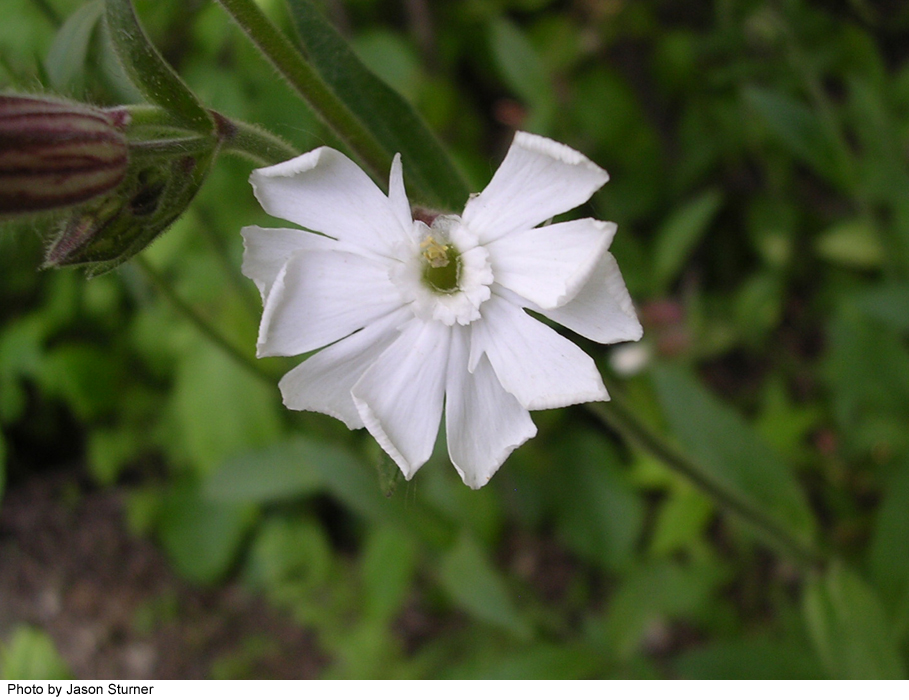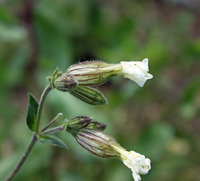Plants annual or short-lived perennial; taproot woody. Stems erect or decumbent at base, branched, to 100 cm, finely hirsute, glandular-puberulent distally. Leaves: blade hirsute on both surfaces; basal usually withering by flowering time, petiolate, blade oblong-lanceolate to elliptic; cauline sessile, reduced into inflorescence, blade lanceolate to elliptic, 3-12 cm × 6-30 mm, apex acute. Inflorescences several-many-flowered (fewer in pistillate plants), open, dichasial cymes, bracteate; bracts much reduced, lanceolate, herbaceous. Pedicels 1-5 cm. Flowers unisexual, some plants having only staminate flowers, others having only pistillate flowers, fragrant, 25-35 mm diam.; in veined staminate plants subsessile to short-pedicellate, in pistillate plants pedicellate; calyx prominently 10-veined in staminate flowers, 20-veined in pistillate, tubular, becoming ovate in pistillate flowers, 10-20(-24) × 8-15 mm in fruit, margins dentate, hirsute and shortly glandular-pubescent, lobes to 6 mm, broadly ovate with apex obtuse, to lanceolate with apex acuminate; petals white, broadly obovate, ca. 2 times calyx, limb spreading, unlobed to 2-lobed; stamens equaling to slightly longer than calyx; stigmas (4-)5, slightly longer than calyx. Capsules ovate, ca. equaling calyx, opening by (4-)5, spreading to slightly reflexed, 2-fid teeth; carpophore 1-2 mm. Seeds dark gray-brown, reniform-rotund, plump, ca. 1.5 mm, coarsely tuberculate. 2n = 24.
Flowering summer-fall. Arable land, roadsides, waste land; 0-2800 m; introduced; Greenland; St. Pierre and Miquelon; Alta., B.C., Man., N.B., Nfld. and Labr. (Nfld.), N.S., Ont., P.E.I., Que., Sask.; Alaska, Ariz., Ark., Calif., Colo., Conn., Del., D.C., Ga., Idaho, Ill., Ind., Iowa, Kans., Ky., Maine, Md., Mass., Mich., Minn., Mo., Mont., Nebr., N.H., N.J., N.Mex., N.Y., N.C., N.Dak., Ohio, Oreg., Pa., R.I., S.C., S.Dak., Tenn., Utah, Vt., Va., Wash., W.Va., Wis., Wyo.; Eurasia.
European botanists recognize several subspecies of Silene latifolia, at least two of which appear to occur in North America: subsp. latifolia [S. alba subsp. divaricata (Reichenbach) Walters], a commonly occurring form here, with acuminate calyx teeth and patent to recurved capsule teeth; and subsp. alba (Miller) Greuter & Burdet, less common in North America, with short, obtuse calyx teeth and erect teeth in the dehisced capsule. However, most of our material tends to be intermediate, making recognition of subspecies here of little value. Presumably there has been extensive gene exchange between populations of this outbreeding species since its introduction into North America.
The name Silene latifolia has been misapplied to S. vulgaris by some authors, which has been a cause of confusion.
Annual or short-lived perennial herb with a woody taproot 40 cm - 1 m tall
Stem: decumbent at the base or upright, branched, finely hairy, glandular above.
Inflorescence: a much-branched, open cluster (dichasial cyme) of several to many flowers, subtended by much-reduced bracts.
Flowers: male or female (some plants having only one or the other), white, 2.5 - 3.5 cm in diameter, fragrant. Stalk upright, to 5 cm long. Stamens ten. Styles mostly five. The flowers open in the evening.
Sepals: fused at the base into a tube (calyx). Calyx tube 1 - 3 cm long, 8 - 15 mm wide, tubular, becoming inflated and egg-shaped in female flowers, ten-veined (in male flowers), twenty-veined (in female flowers), hairy, shortly glandular, with five short lobes. Lobes to 6 mm long, and broadly egg-shaped with a blunt tip to lance-shaped with a pointed tip.
Petals: five, white, 2 - 4 cm long, about two times as long as the calyx, broadly reverse egg-shaped, narrowly clawed, deeply two-lobed or unlobed.
Fruit: a dehiscent capsule, opening by five (appearing as ten) upright or spreading teeth, 1 - 1.5 cm long, more or less equaling calyx, egg-shaped. Seeds dark grayish, about 1.5 mm long, kidney-shaped to rounded, plump, roughened.
Basal leaves: often withering by flowering time, stalked, oblong lance-shaped to elliptic, and hairy.
Stem leaves: opposite, up to ten pairs, stalkless, 3 - 12 cm long, 0.5 - 4 cm wide, lance-shaped to elliptic with a pointed tip, three- to five-veined, and hairy.
Similar species: No information at this time.
Flowering: May to early October
Habitat and ecology: Introduced from Eurasia. A very common weed in many habitats, such as waste ground, cultivated fields, pastures, and along railroads.
Occurence in the Chicago region: non-native
Etymology: Silene probably comes from the Greek word sialon, meaning saliva, referring to the sticky secretion on many of these plants. It may also have come from the word seilenos, referable to Silenus-a foam-covered, drunken character in Greek Mythology. Latifolia means "wide leaves."
Author: The Morton Arboretum
A weed of fallow and cultivated fields and along roadsides. This species is frequently confused with Silene noctiflora. See the discussion under the latter species.
Dioecious annual to more often biennial or short-lived perennial from a stout root, 4-12 dm, usually hairy, becoming glandular above; cauline lvs as many as 10 pairs, lanceolate to broadly elliptic, 3-10 נ1-4 cm, acute, 3-5-nerved, the lower petiolate; infl usually much branched; fls white, odorous, opening in the evening; cal in male fls 1.5-2 cm, 10-nerved, in female 2-3 cm, 20-nerved and becoming much inflated; pet 2-4 cm, the claw exsert, auriculate, the appendages 1-1.5 mm, erose, the blade deeply bilobed; styles mostly 5; fr 10-15 mm, dehiscent by 10 erect or spreading teeth; seeds gray, with blunt tubercles; 2n=24. Native of Europe, established as a common weed throughout much of N. Amer. May-Sept. (S. pratensis; S. alba, a preoccupied name; Lychnis a.)
Gleason, Henry A. & Cronquist, Arthur J. 1991. Manual of vascular plants of northeastern United States and adjacent Canada. lxxv + 910 pp.
©The New York Botanical Garden. All rights reserved. Used by permission.











